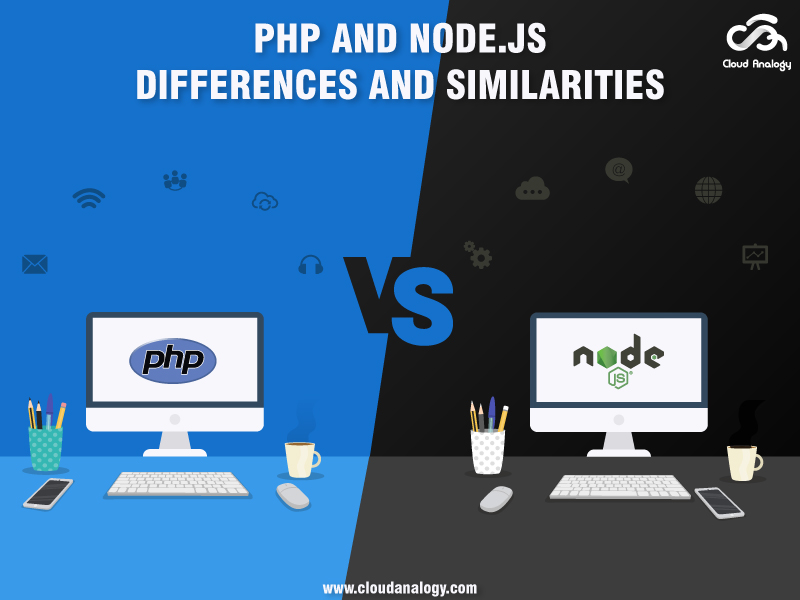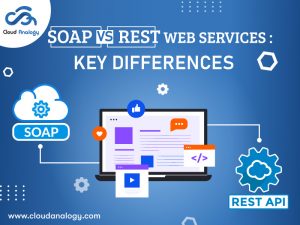Sharing is caring!
Almost every day, new technologies compete and evolve to become users’ favorites and change the landscape of the internet and web development. Backend developers have access to newer and web-focused languages but choosing a perfect solution for a project might be difficult for them.
Likewise, there are two web application development technologies that often confuse people: PHP and Node.js. Before choosing any of these two environments, the developers should be aware of their differences, similarities, and limitations. In this post, we will compare two powerful back-end technologies PHP vs Node.js and will try to determine which technology is better and for what purpose.
Both PHP and Node.js are popular web development applications that power heavy dynamic websites.

PHP - Hypertext Preprocessor
PHP is an open-source, server scripting language that has been designed to develop Static websites, Dynamic websites, and CPU bound applications.
PHP scripts have a .php extension and contain a combination of CSS, HTML, JavaScript, and plain text. It has been used as the first choice among various languages for content management systems (CMS) like WordPress, Drupal, and Joomla. The PHP language works with the web server to make scalable, dynamic, and high-level web applications.
.

Node.js
Node.js is a JavaScript programming language that runs on the server and used to make interactive and dynamic web pages. Node.js is known to have an event-driven architecture with non-blocking I/O capabilities, making it suitable for developing I/O intensive web applications, single-page applications, and other real-time web applications such as chat apps and video streaming applications.
The Node.js file has a .js file extension and contains pure JavaScript code. GoDaddy, IBM, LinkedIn, Netflix, PayPal, and Walmart are some of the most famous Node.js users.
Although Node.js and PHP are both server-side scripting languages, there are also differences between the two scripting languages. Let’s explore the differences and similarities between them.
PHP vs Node.js – The Major Differences
1. Synchronous and Asynchronous
Synchronous code is one that is executed line-by-line and continues to execute the next line of code when the current line has been executed
while Asynchronous code runs all the codes simultaneously.
PHP: PHP is synchronous, but there are several APIs that are kept asynchronous. The problem of being synchronous can be understood with a simple example. For example, the first line of code has a function that takes a long time to execute. Because of the synchronous nature, the following lines of code must wait for their execution time and will execute only when the previous function is executed. This allows users to wait because of the slower process of execution.
Node.js: Node.js is asynchronous, which means that the JavaScript engine executes all the code at once and does not wait for the function to return. The lines of code under the function are executed, and the function also executes and returns the output once the process completes, thus making Node.js fast.
2. CONTEXT SWITCHES
Switching between different environments and languages is associated with poor performance while writing code.
PHP: By writing backend code in PHP, users constantly switch between various languages and syntaxes. This is because PHP is mainly used as part of the LAMP stack which includes MySQL (for databases), PHP (for server side code), the Apache HTTP Server, and Linux. All these have different syntaxes and good knowledge about HTML, CSS, and JavaScript.
Node.js: As Node.js is written in JavaScript, both server-side and client-side are based on JavaScript, so there is no need of changing the language.
3. MODULES
PHP: PHP uses module-based installing technologies such as the PEAR (Veteran Package System) and Composer that are relatively new.
PEAR is a framework and distribution system for reusable PHP components.
Composer is a PHP dependency management tool. Users can declare libraries on which projects depend and Composer manages installation and updation process for the users.
Node.js: Node.js is held with a package management system called NPM (Node Package Manager) and its registry that is easy to use and publish.
4. FRAMEWORKS
PHP: PHP is a very popular server-side scripting language, and it provides various frameworks that help in a simple backend development. Some of them are Laravel, CodeIgniter, and Cakephp. This framework supports the development of flexible, powerful, and secure web applications.
Node.js: Frameworks like ExpressJS, MeteorJS, and Derby Proxy MVC frames are the most popular. From time to time, new frames come up like koa.js, hapi, total.js, sails.js, etc.
5. DATABASES
PHP: PHP is used in collaboration with traditional/relational databases such as MySQL, MariaDB, PostgreSQL, etc. However, there are ways to use NoSQL and PHP databases but they are not very popular.
Node.js: Node.js works well with NoSQL databases (not just SQL) such as MongoDB, CouchDB, and graphical databases such as Neo4j. NPM (node package manager) packages are available for almost all the databases on the NPM registry.
Similarities between PHP and Node.js
- Interpreted Languages – Both PHP and Node.js scripts are interpreted languages, which means that the code can be executed in the respective runtime environments. Both PHP and Node.js are suitable for beginner web developers and web design experts.
- Web Requests – Both are used to handle web requests – they run on the server and handle requests directed to them. PHP and Node.js can be used to process dynamic Web content and interactive Web sites, and data requests.
- Streams – Both PHP and Node.js can also be used to serve streams. Node.js deals more efficiently with the Stream API, while PHP is more complex and requires more complex coding for streaming video. For this reason, Node.js is the preferred platform in many cases because it is easy to use and consume less time. PHP and Node.js nodes can run on multiple platforms, including Linux, macOS, and Windows.
- Scalability – In terms of scalability, both technologies have the potential to be adapted to your circumstances. They can be changed as per the requirements and included into different codes. Both are open source with a rich system of add-ons.
The execution of each platform depends on several variables, including programming, usage, and database. It is difficult to compare the performance of PHP and Node.js because their usage is very different. However, you can do this by looking at monitoring real-time performance of PHP and Node.js.
These two platforms are quite successful when it comes to good performance based upon real world circumstances
Conclusion
It is all about the differences and similarities between the both great server-side language- PHP and Node.js. Both of them have their good and bad parts. In order to make the right choice between one of them, you need to leverage the knowledge of the architectures and ecosystems of both the environments. Choosing Node.js or PHP completely depends upon the project requirements, speed of development, and what type of application you want to build.
Furthermore, one important factor need to be considered is the developer’s skills and expertise who is using the technology and applying to the project. At Cloud Analogy, we have talented PHP and Node.js developers. Contact us at www.cloudanalogy.com if you’re looking for a team to work on your projects or if you are still confused on which technology is good for you.

Akshay Dhiman
Chief Technical Officer
Akshay Dhiman, the CTO of Cloud Analogy, has been a standout and successful Salesforce Platform Developer for years. He has a rich experience in Salesforce Integration, JavaScript, APEX, VisualForce, Force.com Sites, Batch Processing, Lightning, PHP, C++, Java, NodeJs, ReactJs, Angular 8, GraphQL, React Native, Web Technology, and jQuery.Hire the best Salesforce Development Company. Choose certified Salesforce Developers from Cloud Analogy now.







Simply wonderful this comprehensive article. I must say that you have awesome collection of blogs. They are very helpful and simple to understand. Thanks again for knowledge & keep on sharing more with us.
Hey Jacob Mathew, Thanks for your kind words. We’re glad you found our content informative and helpful, and we look forward to sharing more with you.
Keep reading 🙂
What a fantastic post on the difference between these two web application development technologies. This is actually what I was looking for. I can wait to dig deeper and start utilizing the information you have provided.
Hey Anthony, Thanks for your kind words. We’re glad you found our content informative and helpful, and we look forward to sharing more with you.
Keep reading 🙂
Thank you so much for your information,its very useful and helful to me.
Hey Nijah, Thanks for your kind words. We’re glad you found our content informative and helpful, and we look forward to sharing more with you.
Keep reading 🙂
Simply explained. Very much helpful to every beginner. Thanks, Akshay for sharing the informative piece of article with us.
Hey Jax, Thanks for your kind words. We’re glad you found our content informative and helpful, and we look forward to sharing more with you.
Keep reading 🙂